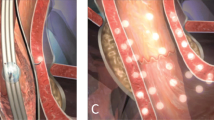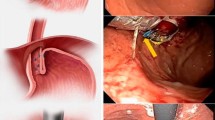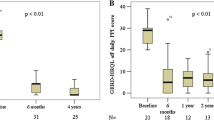Abstract
Background
Endoluminal full-thickness gastroplication has been documented to provide significant and long-lasting improvement of GERD symptoms and health-related quality of life (HRQL) with very little patient morbidity. These treatments, however, are criticized for normalizing esophageal acid exposure in only 30–40% of patients treated. We hypothesize that there are objective criteria that will identify those patients who will have a normal DeMeester score (DMS) following endoluminal treatment.
Methods
Data from a prospective multicenter trial using the NDO Plicator device to treat GERD were available for statistical analysis. All patients were treated with endoluminal full-thickness gastroplication. All patients had GERD symptoms and abnormal 24-h pH exposure preoperatively. Postoperative objective outcome was assessed by performing 24-h pH studies at 6 months. Univariate and multivariate regression analyses were performed to determine factors predictive of successful treatment (normalized 24-h pH).
Results
A total of 266 patients were included in the study. Mean preoperative DMS was 47.91 (±31.34). Postoperatively, mean DMS decreased significantly (37.11 ± 24.63, p < 0.001), and 31.67% of patients had a DMS within normal range (DMS < 22). Results of multivariate regression analysis demonstrated that the following preoperative patient characteristics were predictive of postoperative success (normal DMS): DMS < 30 (odds ratio [OR] = 4.24, 95% confidence interval [CI] = 1.73, 10.36, p < 0.001), heartburn score < 2 (OR = 3.37, CI = 1.44, 7.89, p = 0.005), and BMI < 30 (OR = 4.93, CI = 1.55, 15.61, p = 0.007).
Conclusion
Data analysis from this prospective study indicates that the odds of objective success would be significantly greater if the treatment was restricted to thinner patients with mild reflux disease. This may help define the optimal place for endoluminal therapy in a comprehensive GERD treatment algorithm.


Similar content being viewed by others
References
Nebel OT, Fornes MF, Castell DO (1976) Symptomatic gastroesophageal reflux: incidence and precipitating factors. Am J Dig Dis 21(11):953–956
Locke GR III, Talley NJ, Fett SL, Zinsmeister AR, Melton LJ III (1997) Prevalence and clinical spectrum of gastroesophageal reflux: a population-based study in Olmsted County, Minnesota. Gastroenterology 112(5):1448–1456
Lagergren J, Bergstrom R, Lindgren A, Nyren O (1999) Symptomatic gastroesophageal reflux as a risk factor for esophageal adenocarcinoma. N Engl J Med 340(11):825–831
Pohle T, Domschke W (2000) Results of short- and long-term medical treatment of gastroesophageal reflux disease (GERD). Langenbecks Arch Surg 385(5):317–323
Moayyedi P, Talley NJ (2006) Gastro-oesophageal reflux disease. Lancet 367(9528):2086–2100
Iqbal A, Salinas V, Filipi CJ (2006) Endoscopic therapies of gastroesophageal reflux disease. World J Gastroenterol 12(17):2641–2655
Lutfi RE, Torquati A, Richards WO (2004) Endoscopic treatment modalities for gastroesophageal reflux disease. Surg Endosc 18(9):1299–1315
Pleskow D, Rothstein R, Kozarek R, Haber G, Gostout C, Lo S, Hawes R, Lembo A (2008) Endoscopic full-thickness plication for the treatment of GERD: five-year long-term multicenter results. Surg Endosc 22(2):326–332
Pleskow D, Rothstein R, Kozarek R, Haber G, Gostout C, Lembo A (2007) Endoscopic full-thickness plication for the treatment of GERD: long-term multicenter results. Surg Endosc 21(3):439–444
Johnson LF, DeMeester TR (1974) Twenty-four-hour pH monitoring of the distal esophagus. A quantitative measure of gastroesophageal reflux. Am J Gastroenterol 62(4):325–332
Camilleri M, Dubois D, Coulie B, Jones M, Kahrilas PJ, Rentz AM, Sonnenberg A, Stanghellini V, Stewart WF, Tack J, Talley NJ, Whitehead W, Revicki DA (2005) Prevalence and socioeconomic impact of upper gastrointestinal disorders in the United States: results of the US Upper Gastrointestinal Study. Clin Gastroenterol Hepatol 3(6):543–552
Wahlqvist P, Brook RA, Campbell SM, Wallander MA, Alexander AM, Smeeding JE, Kleinman NL (2008) Objective measurement of work absence and on-the-job productivity: a case-control study of US employees with and without gastroesophageal reflux disease. J Occup Environ Med 50(1):25–31
Tam WC, Holloway RH, Dent J, Rigda R, Schoeman MN (2004) Impact of endoscopic suturing of the gastroesophageal junction on lower esophageal sphincter function and gastroesophageal reflux in patients with reflux disease. Am J Gastroenterol 99(2):195–202
Chuttani R, Sud R, Sachdev G, Puri R, Kozarek R, Haber G, Pleskow D, Zaman M, Lembo A (2003) A novel endoscopic full-thickness plicator for the treatment of GERD: a pilot study. Gastrointest Endosc 58(5):770–776
Rothstein R, Filipi C, Caca K, Pruitt R, Mergener K, Torquati A, Haber G, Chen Y, Chang K, Wong D, Deviere J, Pleskow D, Lightdale C, Ades A, Kozarek R, Richards W, Lembo A (2006) Endoscopic full-thickness plication for the treatment of gastroesophageal reflux disease: a randomized, sham-controlled trial. Gastroenterology 131(3):704–712
Pleskow D, Rothstein R, Lo S, Hawes R, Kozarek R, Haber G, Gostout C, Lembo A (2004) Endoscopic full-thickness plication for the treatment of GERD: a multicenter trial. Gastrointest Endosc 59(2):163–171
Tack J, Koek G, Demedts I, Sifrim D, Janssens J (2004) Gastroesophageal reflux disease poorly responsive to single-dose proton pump inhibitors in patients without Barrett’s esophagus: acid reflux, bile reflux, or both? Am J Gastroenterol 99(6):981–988
O’Boyle CJ, Watson DI, DeBeaux AC, Jamieson GG (2002) Preoperative prediction of long-term outcome following laparoscopic fundoplication. ANZ J Surg 72(7):471–475
Power C, Maguire D, McAnena O (2004) Factors contributing to failure of laparoscopic Nissen fundoplication and the predictive value of preoperative assessment. Am J Surg 187(4):457–463
Campos GM, Peters JH, DeMeester TR, Oberg S, Crookes PF, Tan S, DeMeester SR, Hagen JA, Bremner CG (1999) Multivariate analysis of factors predicting outcome after laparoscopic Nissen fundoplication. J Gastrointest Surg 3(3):292–300
Jackson PG, Gleiber MA, Askari R, Evans SR (2001) Predictors of outcome in 100 consecutive laparoscopic antireflux procedures. Am J Surg 181(3):231–235
Soper NJ, Dunnegan D (1999) Anatomic fundoplication failure after laparoscopic antireflux surgery. Ann Surg 229(5):669–676
Khajanchee YS, Hong D, Hansen PD, Swanstrom LL (2004) Outcomes of antireflux surgery in patients with normal preoperative 24-hour pH test results. Am J Surg 187(5):599–603
Herbella FA, Sweet MP, Tedesco P, Nipomnick I, Patti MG (2007) Gastroesophageal reflux disease and obesity. Pathophysiology and implications for treatment. J Gastrointest Surg 11(3):286–290
Wajed SA, Streets CG, Bremner CG, DeMeester TR (2001) Elevated body mass disrupts the barrier to gastroesophageal reflux. Arch Surg 136(9):1014–1018 (discussion 1018–1019)
Patterson EJ, Davis DG, Khajanchee Y, Swanstrom LL (2003) Comparison of objective outcomes following laparoscopic Nissen fundoplication versus laparoscopic gastric bypass in the morbidly obese with heartburn. Surg Endosc 17(10):1561–1565
Winslow ER, Frisella MM, Soper NJ, Klingensmith ME (2003) Obesity does not adversely affect the outcome of laparoscopic antireflux surgery (LARS). Surg Endosc 17(12):2003–2011
Morgenthal CB, Lin E, Shane MD, Hunter JG, Smith CD (2007) Who will fail laparoscopic Nissen fundoplication? Preoperative prediction of long-term outcomes. Surg Endosc 21(11):1978–1984
Bremner RM, Bremner CG, DeMeester TR (1995) Gastroesophageal reflux: the use of pH monitoring. Curr Probl Surg 32(6):429–558
Costantini M, Crookes PF, Bremner RM, Hoeft SF, Ehsan A, Peters JH, Bremner CG, DeMeester TR (1993) Value of physiologic assessment of foregut symptoms in a surgical practice. Surgery 114(4):780–786
Liu JJ, Carr-Locke DL, Lee LS, Brooks DC, Saltzman JR (2004) Endoluminal gastroplication for treatment of patients with classic gastroesophageal reflux symptoms and borderline 24-h pH studies. Scand J Gastroenterol 39(7):615–620
Mainie I, Tutuian R, Castell DO (2006) Comparison between the combined analysis and the DeMeester Score to predict response to PPI therapy. J Clin Gastroenterol 40(7):602–605
Author information
Authors and Affiliations
Corresponding author
Rights and permissions
About this article
Cite this article
Khajanchee, Y.S., Ujiki, M., Dunst, C.M. et al. Patient factors predictive of 24-h pH normalization following endoluminal gastroplication for GERD. Surg Endosc 23, 2525–2530 (2009). https://doi.org/10.1007/s00464-009-0448-9
Received:
Revised:
Accepted:
Published:
Issue Date:
DOI: https://doi.org/10.1007/s00464-009-0448-9




